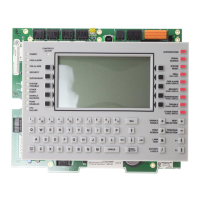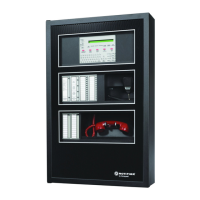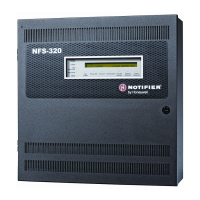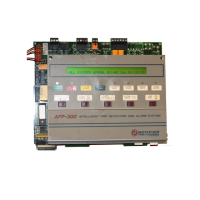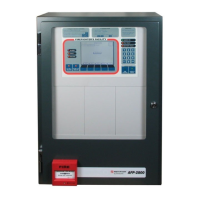32 NFS2-3030 Operations Manual — P/N 52546:N1 06/20//2014
Operation of the Control Panel System or Point Trouble Event
System Troubles
A message from the “Trouble Type” column in Table 2.2 will appear in the second line on the left
of the panel display when a device trouble occurs. Use this table to help determine the cause of the
trouble.
SOUNDER NO
ANSWER
The sounder base is no longer communicating with the
loop card.
Investigate and fix.
THERM. TROUBLE The thermistors are not functioning properly on a FSC-
851 detector. This trouble is generated for FlashScan
mode only.
Replace the detector.
TIME BASE FAULT The time needs to be set on the FAAST detector. Use PipeIQ to download the FAAST configuration.
TROUBLE1 An FMM-4-20 module threshold trouble as determined
in point programming.
Refer to the NFS2-3030 programming manual.
TROUBLE2 An FMM-4-20 module threshold trouble as determined
in point programming.
Refer to the NFS2-3030 programming manual.
UNDER RANGE The FMM-4-20’s 4-20 mA sensor has dropped below
4mA.
Determine if the sensor is functional and correctly installed.
VERIFY OVER MAX This detector or FZM-1 monitor module, which has been
programmed to participate in alarm verification, has
gone into and come out of its programmed verification
limit without going into alarm. Either something is wrong
with the detector or there is a condition nearby (such as
someone smoking) that causes it to go into verification
frequently.
Check the detector and the conditions nearby to determine the
problem.
WEAK LINK FAULT
†
The weak link trouble denotes a connection of
insufficient primary parent link signal strength.
To resolve a weak link fault:
Reduce the distance between devices, place them away from
obstructions, or add a repeater.
Tamper the device when moving it to a new location.
Restart mesh formation after a repeater is installed or after a
device has been relocated and the tamper condition is cleared.
Terminate mesh formation once the devices have joined the
mesh or allow mesh formation to timeout.
Restructuring will automatically start and the FWSG will
reevaluate the link connectivity between all devices and select
suitable signal paths.
WIRELESS NO
ANSWER
†
The wireless device is not responding. Either the device
is not working or it is not connected properly.
Determine whether the device is functional, and connected
and addressed properly on the FWSG.
(This trouble will latch until a reset is performed on the FACP
and/or FWSG)
WIRING FAULT The detector has discovered a fault in the VESDAnet
wiring.
Inspect the VESDAnet wiring and correct the condition.
* This trouble may be fire panel or backup battery related. Test and replace backup batteries if necessary.
†
For additional information on wireless device troubles, refer to the SWIFT Smart Wireless Integrated Fire Technology manual.
POINT TROUBLES
TROUBLE TYPE TROUBLE DESCRIPTION ACTION
Table 2.1 Point (Device) Troubles (4 of 4)
SYSTEM TROUBLES
TROUBLE MESSAGE TYPE TROUBLE DESCRIPTION
AA TROUBLE BUS FAIL The AA Trouble Bus has failed. Investigate and fix.
AC FAIL Loss of AC power. Investigate whether there is an AC power loss, or whether the power supply is correctly
installed and wired.
ADV WALK TEST There is an Advanced Walk Test in progress.
AMPLIFIER LIMIT The DAA is overloaded. Remove outputs to lower the load on the speaker circuits. Press reset when done.
AMPLIFIER SUPERVISION The amplifier’s internal supervision is not working. Call Technical Services.
AMPLIFIER TROUBLE The DAA is in trouble. The output is overloaded or the amplifier is damaged. Remove outputs to determine if
the DAA was overloaded. If it still does not work, call Technical Services.
ANALOG OUTPUT x
TROUBLE A trouble has occurred on DVC-AO analog output x (1 - 4). The analog output is configured for Style 7, but no
audio signal is returned. Investigate and fix.
ANNUN x
NO ANSWER The annunciator at address x is not responding.
ANNUN x
TROUBLE The annunciator at address x is in trouble.
AUDIO LIBRARY CORRUPTED The DVC’s audio library is corrupted. Re-create and/or re-download an intact database.
AUDIO LIBRARY INCOMPATIBLE The audio library version is incompatible with the database and/or the application version.
AUXILIARY TROUBLE Auxiliary device connected to the NFS2-3030 CPU at J5 is in trouble or cable is missing.
Table 2.2 System Troubles (1 of 4)
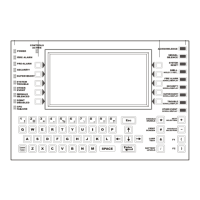
